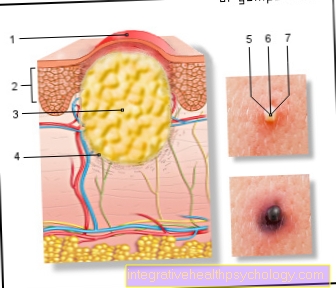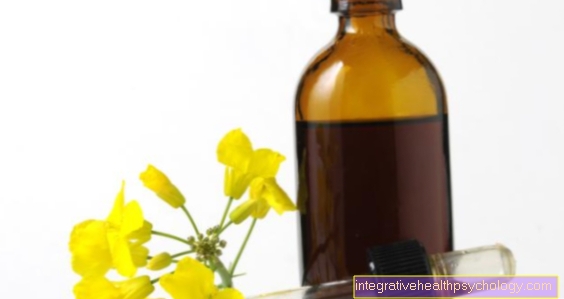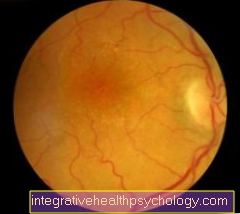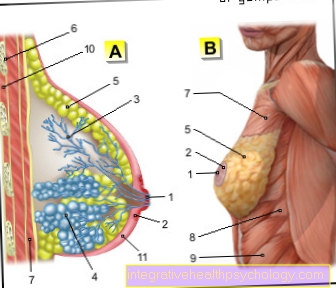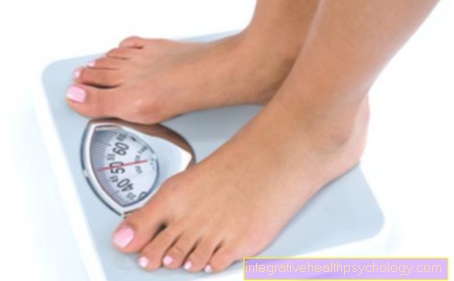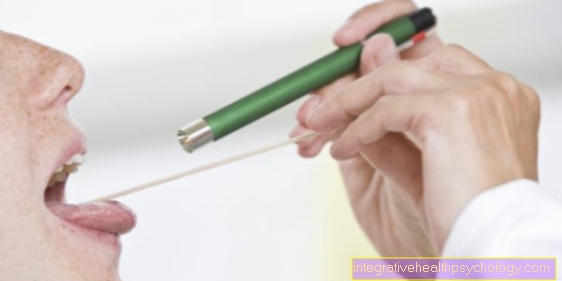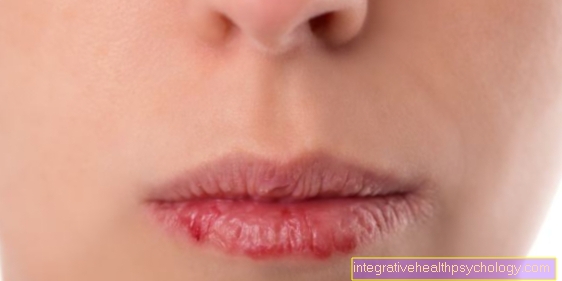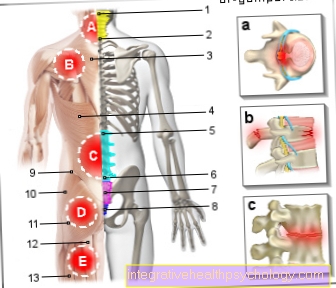Betaisodona® solution
introduction
Betaisodona® solution is a germicidal agent that contains an iodine-containing chemical compound as an active ingredient. The solution is used on the one hand for the one-time disinfection of skin or mucous membranes before an operation and on the other hand for the supportive treatment of open wounds.
It has the same effect as the iodine tinctures used in the medicine cabinet without causing severe skin irritation.
The use of Betaisodona® solution only seldom leads to side effects, but long-term wounds or infections should be treated by a doctor and not treated with Betaisodona® solution without consultation.
You might also be interested in these topics:
- Betaisodona® ointment
- Betaisodona® wound gel

Indications - When is Betaisodona® solution used?
Betaisodona® solution is intended for two main indications according to the package insert.
On the one hand, it is used in hospitals or medical practices before operations, during childbirth, before tissue is removed (biopsy) and during surgical hand disinfection. Depending on the specifications of the hospital, either Betaisodona® solution or an agent with a comparable effect is used.
The second indication for which the solution is intended is for use on wounds such as lower leg ulcers, burns and inflamed open wounds. The Betaisodona® solution kills germs and supports wound healing in the body.
Betaisodona® solution can also be used for wounds that are drawn in everyday life, such as a scrape after a fall. In the case of very large wounds, heavy bleeding or severe discomfort, however, a doctor should be consulted as soon as possible.
General information about Betaisodona can be found at: Betaisodona
Betaisodona® solution against pimples
It is possible to use Betaisodona® solution against pimples. Certain bacteria play an important role in causing pimples. Especially with large and inflamed pimples, the germicidal effect can promote healing.
However, if the pimples are deep and closed, the application of Betaisodona® solution will not help. Likewise, this remedy cannot counteract the development of new pimples, as these arise due to excessive production of the sebum glands.
In order to start effective pimple therapy for very pronounced acne, you should consult a family doctor. In general, the face should be cleaned regularly and not excessively moisturized. Lighter forms of acne usually resolve on their own in the course of the second decade, so that no new pimples appear.
You might also be interested in: How to Get Rid of Pimples
Betaisodona® solution after a piercing
After a piercing, there is an increased risk that the skin damage caused will spread germs and then lead to inflammation.
By applying Betaisodona® solution in the area of the piercing, the germs are killed. Regular use can prevent inflammation.
As soon as the piercing site has healed, the Betaisodona® solution should no longer be used. If the piercing has already become infected, it is not enough to treat the wound with Betaisodona® solution or another disinfectant. In such a case, the piercing must be removed again.
Can I also use Betaisodona solution on open wounds?
Betaisodona® solution is basically also suitable for treating open wounds. Abrasions in particular, such as those following a fall on the knee, can be freed from germs well with Betaisodona® solution.
A wound caused by an injury in which not only the top layer of skin has been abraded should always be seen by a doctor. The same applies to deep cuts. The doctor can take care of the wound and check if the tetanus protection needs to be renewed.
Betaisodona® solution is also used to treat other open wounds, such as an ulcer due to a venous disease. Here, too, however, professionally guided wound treatment is required and self-treatment with Betaisodona® solution alone is not recommended.
Betaisodona® solution for nail bed inflammation
An inflammation of the nail bed can be treated with Betaisodona® solution. This kills the germs and the body can fight the inflammation. In some cases, however, additional treatment measures are required.
If the inflammation does not heal within a week or if the symptoms continue to increase despite the use of Betaisodona® solution, a doctor should be consulted. They will examine the nail bed inflammation and then decide whether, for example, the use of a medication is necessary.
A purulent inflammation may even require minor surgery to treat it to avoid complications such as spreading the inflammation to bones or tendons.
Learn more about this at: Treatment of inflammation of the nail bed
Betaisodona® solution as a foot bath
It is possible to have a foot bath with Betaisodona® solution. To do this, the solution is diluted in a ratio of about 1:25 with normal tap water.
It is advisable to first pour the water into the vessel and then add the measured amount of Betaisodona® solution. This can prevent possible discoloration of the vessel.
A footbath can be used for wounds on the foot or for diabetic foot syndrome with open areas to reduce the number of germs on the skin and promote healing. Whether a foot bath with Betaisodona® solution makes sense, and if so, how often and for how long it should be done, can be discussed with your family doctor, for example.
Active ingredient of the Betaisodona® solution
The active ingredient of Betaisodona® solution is povidone iodine. It is a chemical compound that contains the element iodine. When Betaisodona® solution is applied, iodine particles are continuously released from the compound. It is believed that so-called radicals form on the skin in connection with water. These chemical particles have a germicidal (antiseptic) Effect.
In contrast to some other disinfectants, iodine covers the entire spectrum of germs. It works
- bactericidal (against bacteria),
- fungicidal (against fungi),
- virucidal (against viruses) and
- sporocidal (against spores).
Since there is a slow release of iodine, Betaisodona® solution, in contrast to the iodine tinctures that used to be common in the medicine cabinet, usually does not cause severe skin irritation. However, the active substance typically turns the skin brown. However, this disappears by itself and can be washed off your hands, for example.
The effect of Betaisodona® solution and other iodine-containing agents diminishes even after repeated use and there is no known resistance of pathogens to iodine.
How does Betaisodona® solution influence wound healing?
Betaisodona® solution affects wound healing only indirectly. It kills all germs such as bacteria, fungi or viruses in the applied area. This prevents inflammation of the wound or reduces the number of germs in already infected wounds.
The actual wound healing is a complicated process that the body can only perform on its own. The germicidal effect of Betaisodona® solution enables wound healing to proceed without the disturbing influence of bacteria or fungi.
Side effects of Betaisodona® solution
In most cases, side effects are not to be feared when using Betaisodona® solution.
It should be noted, however, that some people are allergic to iodine. In order to avoid an allergic shock, it should not be used on these people.
- Only in rare cases, i.e. less than one in a thousand cases, does a skin hypersensitivity reaction occur. Symptoms of an allergy such as itching, redness or blisters can occur a few hours to days after the first application.
- Very rarely, i.e. fewer than one in 10,000 users, Betaisodona® solution causes more dangerous symptoms such as shortness of breath or circulatory problems.
- Side effects were also very rarely caused by the absorption of iodine into the bloodstream. In the case of large open and burn wounds, significant amounts of the element can enter the circulation. In the worst case, the iodine from the Betaisodona® solution can trigger an overactive thyroid gland (iodine-induced hyperthyroidism) in patients who have a thyroid disease that was often undetected until then. Symptoms of this extremely rare side effect include an accelerated pulse rate, inner restlessness and fever.
- Also extremely rarely and only described in patients with severe burns, the use of Betaisodona® solution can lead to an impairment of kidney function and over-acidification of the blood as a side effect.
However, with everyday wounds and the routine use of Betaisodona® solution before an operation, these side effects are not to be feared.
What interactions does Betaisodona® solution cause?
Since Betaisodona® solution works almost exclusively locally at the point where it is applied, there is no need to fear interactions with other drugs or luxury foods such as alcohol.
Only in the case of very large wounds and extensive burns is part of the element iodine released from the Betaisodona® solution absorbed into the bloodstream. The only organ in the body that can utilize this is the thyroid. If this is healthy, however, excess iodine is ignored and excreted through the kidneys.
However, if there is a thyroid disease, the iodine from the Betaisodona® solution can, in very rare cases and in certain cases, be influenced. However, even when taking thyroid medication, there is usually no risk of interaction.
Betaisodona® solution should not be combined with other disinfectants, otherwise the effectiveness can be weakened.
Can I use Betaisodona® solution during pregnancy and breastfeeding?
Betaisodona® solution should only be used during pregnancy and breastfeeding as directed by a doctor. No direct harm to mother or child is to be expected, but on the other hand there is also no evidence that it is safe to use.
The theoretically possible but very rare side effect of using Betaisodona® solution is the triggering of an overactive thyroid. This is particularly dangerous during pregnancy and can even trigger a miscarriage. However, in many cases the Betaisodona® solution can be used. It is important to inform the doctor that the patient is pregnant or breastfeeding. This can then decide whether the application is still possible without hesitation.
Does Betaisodona® solution affect the effect of the pill?
The effectiveness of a hormone-containing contraceptive (“pill”) is in no way affected by the use of Betaisodona® solution. The active ingredient of the antiseptic is barely absorbed by the body and does not lead to a change in the effectiveness of the hormone preparation there either. All other forms of contraception remain unaffected when using Betaisodona® solution.
Contraindications - When should Betaisodona® solution not be used?
Betaisodona® solution must not be used if there is hypersensitivity to the ingredients. If you have ever had allergic reactions in the form of itching or blistering from the use of a disinfectant containing iodine, Betaisodona® solution should not be given. In such a case, you can switch to an iodine-free disinfectant.
In a specific skin disease with blistering of the subcutaneous tissue called Dermatitis herpetiformis Duhring Betaisodona® solution must not be used.
There are also relative contraindications in young children and babies. The use of Betaisodona® solution is usually possible without hesitation, but should only be done after consulting a doctor.
Another contraindication is a well-known hyperthyroidism.
If radioiodine therapy is planned in the coming weeks, Betaisodona® solution should also not be used.
What alternatives to the Betaisodona® solution are there?
As an alternative to Betaisodona® solution, Betaisodona® wound gel, for example, can be used. It contains the same active ingredient and mainly differs in consistency. There are also other germicidal solutions that work on the basis of iodine. There are even products that contain exactly the same ingredients and are only sold by a different manufacturer and therefore have a different name.
Often, however, disinfectants are used which, unlike Betaisodona® solution, do not contain iodine. There are a number of alternative preparations with different active ingredients such as special alcohols.
You can also find out more at:
- Bepanthen® antiseptic ointment
- Zinc ointment
- Betaisodona spray
Dosage of Betaisodona® solution
When dosing Betaisodona® solution, care should be taken to ensure that the skin area to be disinfected is completely wetted.
Possible gaps can be recognized by the fact that the skin does not turn brown in the corresponding area. If necessary, a little Betaisodona® solution should be applied here.
However, care should be taken to ensure that no excess of the solution in the form of a “puddle” collects in the wound. Otherwise, the skin may soften and wound healing may be impeded.
Application of Betaisodona® solution
Betaisodona® solution can be applied undiluted or diluted with cold water.
For larger or infected wounds, the agent should be applied undiluted. For small abrasions, a 1: 1 dilution is sufficient. Betaisodona® solution should only be applied to the affected skin area.
The amount to be used must be sufficient to completely wet the wound. However, no solution should collect or "overflow". However, to protect clothing, furniture or the floor, it is advisable to use a mat during application.
Betaisodona® solution is only intended for superficial use on the skin. Under no circumstances should it be drunk or used internally in any other way.
For most skin areas, an exposure time of two minutes is sufficient. For skin rich in sebum, such as the face, Betaisodona® solution should act for at least ten minutes.
A decrease in the effect can be seen when the brown color of the skin disappears again due to the iodine solution. If necessary, the application with Betaisodona® solution should then be repeated. Your doctor or pharmacist can give precise instructions on how and how long to use the solution.
How expensive is Betaisodona® solution?
The price for Betaisodona® solution varies and is primarily based on the size of the pack, although the price per quantity is significantly lower for larger packs. So if you need larger quantities or use Betaisodona® solution frequently, it is better to buy a larger pack.
- The price for the smallest available bottle with 30ml is around three euros.
- 100ml of the solution cost around ten euros.
- With an amount of one liter (1,000 ml), the price is usually a little under 30 euros.
- In some cases three of these large bottles are offered together on the Internet at a discounted price of less than 70 euros.
It is worth paying attention to offers and comparing prices. Large amounts are usually cheaper on the Internet. In the case of smaller bottles, on the other hand, it is often not worth buying on the Internet compared to a normal pharmacy, as you usually have to pay shipping costs.
Shelf life of Betaisodona® solution
Betaisodona® solution is stable for up to three years after first opening. It is therefore advisable, especially for larger bottles, to note the date of opening on the label.
If the minimum shelf life specified by the manufacturer has expired, there is no longer any guarantee of effectiveness. However, if the bottle is intact and has never been heated above 25 ° C, the Betaisodona® solution can still be used in most cases.
There is an exception if the Betaisodona® solution has largely become discolored. If in doubt, old and expired bottles should be discarded and a new one bought.
Betaisodona® solution stings the wound - is that normal?
Often there was a slight burning sensation when applying Betaisodona® solution to a wound. As long as this is bearable and subsides after a few seconds to a few minutes, this is normal. The iodine released from the Betaisodona® solution not only kills the germs but also irritates the skin and the open wound somewhat, which leads to the unpleasant burning sensation.
However, this is much less pronounced than with the iodine tinctures that used to be common in the medicine cabinet, as these contain iodine without a protective chemical compound like in the Betaisodona® solution.
However, if severe burning pain occurs when using the solution, which does not subside at all, a doctor must be consulted. In extremely rare cases, an intolerance reaction to Betaisodona® solution is responsible for the symptoms.
Further dosage forms of Betaisodona®
In addition to the solution, there is Betaisodona, for example in the form of an oral antiseptic. This is used, for example, once before an operation in the oral cavity. An inflammation of the oral mucosa, for example as a result of radiation therapy, can be treated with Betaisodona® oral antiseptic.
Another form is the Betaisodona® ointment. Similar to Betaisodona® solution, this is used on damaged skin such as pressure sores (pressure ulcers), lower leg ulcers or burns. It can also be used, for example, to apply an ointment bandage.
However, another special form of betaisodona, namely wound gauze, is also suitable for such a purpose. It is a kind of cellulose that is soaked with the active ingredient and is placed directly on the injured or diseased skin area and secured with a bandage.
Another form of betaisodona that you can buy is a liquid soap. This is used by surgeons, for example, to wash their hands before an operation.
Also read: Betaisodona® ointment or Betaisodona oral antiseptic
Does Betaisodona® solution require a prescription?
Betaisodona® solution does not require a prescription. This can be ordered in all sizes without a prescription both in the local pharmacy and on the Internet. Although Betaisodona® solution does not require a prescription, a doctor should always be consulted with large or poorly healing wounds, as treatment with this agent alone is not sufficient in such a case.
Recommendations from the editorial team
You might also be interested in:
- Betaisodona wound gel
- Betaisodona® ointment
- Bepanthen® wound and healing ointment
- Bepanthen® antiseptic ointment
- Zinc ointment
Exclusion of liability / disclaimer
We would like to point out that medication must never be discontinued, applied or changed independently without consulting your doctor.
Please note that we cannot claim that our texts are complete or correct. The information may be out of date due to current developments.


